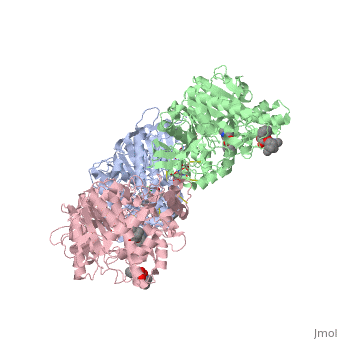1mx5
From Proteopedia
Crystal Structure of Human Liver Carboxylesterase in complexed with homatropine, a cocaine analogue
Structural highlights
FunctionEST1_HUMAN Involved in the detoxification of xenobiotics and in the activation of ester and amide prodrugs. Hydrolyzes aromatic and aliphatic esters, but has no catalytic activity toward amides or a fatty acyl-CoA ester. Hydrolyzes the methyl ester group of cocaine to form benzoylecgonine. Catalyzes the transesterification of cocaine to form cocaethylene. Displays fatty acid ethyl ester synthase activity, catalyzing the ethyl esterification of oleic acid to ethyloleate.[1] [2] Evolutionary ConservationCheck, as determined by ConSurfDB. You may read the explanation of the method and the full data available from ConSurf. Publication Abstract from PubMedWe present the first crystal structures of a human protein bound to analogs of cocaine and heroin. Human carboxylesterase 1 (hCE1) is a broad-spectrum bioscavenger that catalyzes the hydrolysis of heroin and cocaine, and the detoxification of organophosphate chemical weapons, such as sarin, soman and tabun. Crystal structures of the hCE1 glycoprotein in complex with the cocaine analog homatropine and the heroin analog naloxone provide explicit details about narcotic metabolism in humans. The hCE1 active site contains both specific and promiscuous compartments, which enable the enzyme to act on structurally distinct chemicals. A selective surface ligand-binding site regulates the trimer-hexamer equilibrium of hCE1 and allows each hCE1 monomer to bind two narcotic molecules simultaneously. The bioscavenger properties of hCE1 can likely be used to treat both narcotic overdose and chemical weapon exposure. Structural basis of heroin and cocaine metabolism by a promiscuous human drug-processing enzyme.,Bencharit S, Morton CL, Xue Y, Potter PM, Redinbo MR Nat Struct Biol. 2003 May;10(5):349-56. PMID:12679808[3] From MEDLINE®/PubMed®, a database of the U.S. National Library of Medicine. See AlsoReferences
| ||||||||||||||||||||


